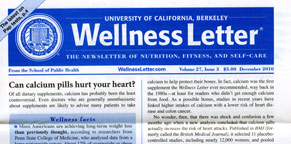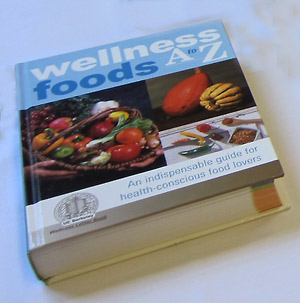Pioneering UC Berkeley Wellness Letter celebrates its silver anniversary
For more than a generation, people looking for plain-spoken, science-based guidance on healthy living have turned to a short-on-frills, long-on-substance, monthly known as the UC Berkeley Wellness Letter.
November 16, 2010
What are very latest research findings on the benefits and risks of screening mammograms? On taking hormones at menopause? On getting a CT scan, despite the radiation exposure?
For more than a generation, people looking for plain-spoken, science-based guidance on healthy living — especially when the science on a given matter is unsettled and popular-media treatment sheds little light — have turned to a no-frills, long-on-substance, advertising-free monthly known as the University of California, Berkeley Wellness Letter.

Under the UC Berkeley Wellness Letter masthead, editors at the School of Public Health have distributed health-related information for more than a quarter century.
On Friday, Nov. 12, the principals behind the pioneering newsletter paused to mark its 25th anniversary — a year late, admittedly, but with characteristic aplomb — filling the Faculty Club Heyns Room with tributes to the Wellness Letter’s long and successful run, and to plans and hopes for its future.
For the School of Public Health (SPH), which launched the newsletter in 1984 in partnership with a New York-based health publisher, the UC Berkeley Wellness Letter — which now boasts more than 240,000 subscribers — has been a remarkably successful “two for one,” Public Health Dean Stephen Shortell told the celebrants. “It embodies our values — promoting healthy people and communities” while helping to train “future generations of students who reinforce that [public health] message.” The school decided early on to funnel its royalties from sale of the Wellness Letter into graduate-student support; so far it has generated at least $10 million to that end, Shortell said.
Dale Ogar, the newsletter’s managing editor since the first edition, emphasizes that the Wellness Letter is “all about evidence-based medicine.” The editorial board, chaired by SPH Clinical Professor John Swartzberg, has “taken a very, very firm stand,” she says, against “purely anecdotal reports” and unsupported claims — for which the dietary-supplement industry, most notably, is notorious.
According to Ogar, readers flood the Wellness Letter in-box with questions about supplements. Many “want to believe the claims,” she notes, even when there’s no supporting evidence. “So much of it is highly bogus.” Typical Wellness Letter advice, whenever reputable research is missing: “The claims on the manufacturer’s website are carefully designed to sound highly scientific, but they are deceptive, and we advise you not to take this supplement.”

The Wellness Letter has published a series of special reports and books — among them Wellness Foods A to Z.
The editorial board’s rigorous standards have earned public confidence, Ogar says, and “made a huge difference in people taking a proactive approach to their healthcare.”
Mike Cunnion, CEO of Remedy Health Media, SPH’s new partner in the public-private venture, estimated that the Wellness Letter “has touched 10 to 12 million lives with great wellness information, and helped people, under the Berkeley seal, with their health.”
From the beginning, the project “has really been about innovation,” Cunnion added.
Even the term “wellness” was a stretch in the early 1980s — when publisher Rodney Friedman first approached Professor Sheldon Margen and SPH Dean Joyce Lashof about co-producing a health newsletter emphasizing nutrition, fitness, and self-care rather than treatment of ailments and diseases once a person is sick. When he proposed the name, the academics initially recoiled, Ogar says. By their lights, “wellness” smacked of “flakiness,” following publicity about a center called The Wellness Place — where clients reportedly “were tickled with peacock feathers while sitting in hot tubs and getting massages,” she recalls. The UC Regents had agreed to give the University’s imprimatur on a public-private enterprise (at that time rather rare), but “wellness,” surely, they would never go for. Yet Friedman was insistent, “everyone ultimately agreed,” and the term eventually earned a place in the dictionary and came to identify a burgeoning movement.
The Wellness Letter helped to launch that movement, Cunnion said.
Looking ahead, Remedy hopes to reach an even wider audience with the reliable health-related information from UC Berkeley Wellness Letter editors, he said. Cunnion cited a new series of free, topic-specific health “Wellness Alerts,” sent via e-mail, and a series of online wellness reports — like the topic-specific guides that the UC Berkeley Wellness Letter first published in the early 1990s — now downloadable from the Web. The first, to be released soon, will cover hypertension.